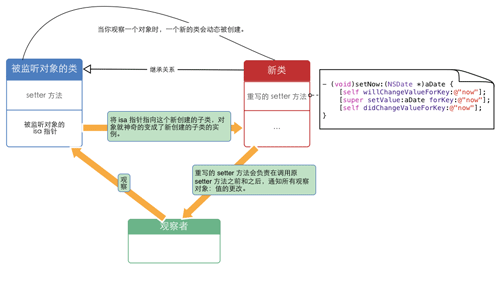KVC KVO高阶应用
本文为投稿文章,作者:Zhiyi( 博客 )
KVC, KVO作为一种魔法贯穿日常Cocoa开发,笔者原先是准备写一篇对其的全面总结,可网络上对其的表面介绍已经够多了,除去基本层面的使用,笔者跟大家谈下平常在网络上没有提及的KVC, KVO进阶知识。旨在分享交流。
目录:
-
KVC的消息传递
-
KVC容器操作
-
KVC与容器类(集合代理对象)
-
KVO和容器类
-
KVO的实现原理
KVC的消息传递
valueForKey:的使用并不仅仅用来取值那么简单,还有很多特殊的用法,集合类也覆盖了这个方法,通过调用valueForKey:给容器中每一个对象发送操作消息,并且结果会被保存在一个新的容器中返回,这样我们能很方便地利用一个容器对象创建另一个容器对象。另外,valueForKeyPath:还能实现多个消息的传递。一个例子:
NSArray *array = [NSArray arrayWithObject:@"10.11", @"20.22", nil]; NSArray *resultArray = [array valueForKeyPath:@"doubleValue.intValue"]; NSLog(@"%@", resultArray); //打印结果 ( 10, 20 )
KVC容器操作
容器不仅仅能使用KVC方法实现对容器成员传递普通的操作消息,KVC还定义了特殊的一些常用操作,使用valueForKeyPath:结合操作符来使用,所定义的keyPath格式入下图所示

Left key path:如果有,则代表需要操作的对象路径(相对于调用者)
Collection operator:以"@"开头的操作符
Right key path:指定被操作的属性
常规操作符:
@avg、@count、@max、@min、@sum
对象操作符:
@distinctUnionOfObjects、@unionOfObjects
NSArray *values = [object valueForKeyPath:@"@unionOfObjects.value"];
@distinctUnionOfObjects操作符返回被操作对象指定属性的集合并做去重操作,而@unionOfObjects则允许重复。如果其中任何涉及的对象为nil,则抛出异常。
Array和Set操作符:
Array和Set操作符操作对象是嵌套型的集合对象
-
@distinctUnionOfArrays、@unionOfArrays
NSArray *values = [arrayOfobjectsArrays valueForKeyPath:@"@distinctUnionOfArrays.value"];
同样的,返回被操作集合下的集合中的对象的指定属性的集合,并且做去重操作,而@unionOfObjects则允许重复。如果其中任何涉及的对象为nil,则抛出异常。
-
@distinctUnionOfSets
NSSet *values = [setOfobjectsSets valueForKeyPath:@"@distinctUnionOfSets.value"];
返回结果同理于NSArray。
据官方文档说明,目前还不支持自动以操作符。
KVC与容器类(集合代理对象)
当然对象的属性可以是一对一的,也可以是一对多。属性的一对多关系其实就是一种对容器类的映射。如果有一个名为numbers的数组属性,我们可以使用valueForKey:@"numbers"来获取,这个是没问题的,但KVC还能使用更灵活的方式管理集合。——集合代理对象
ElfinsArray.h @interface ElfinsArray : NSObject @property (assign ,nonatomic) NSUInteger count; - (NSUInteger)countOfElfins; - (id)objectInElfinsAtIndex:(NSUInteger)index; @end ElfinsArray.m #import "ElfinsArray.h" @implementation ElfinsArray - (NSUInteger)countOfElfins { return self.count; } - (id)objectInElfinsAtIndex:(NSUInteger)index { return [NSString stringWithFormat:@"小精灵%lu", (unsigned long)index]; } @end Main.m - (void)work { ElfinsArray *elfinsArr = [ElfinsArray alloc] init]; elfinsArr.count = 3; NSArray *elfins = [ElfinsArray valueForKey:@"elfins"]; //elfins为KVC代理数组 NSLog(@"%@", elfins); //打印结果 ( "小精灵0", "小精灵1", "小精灵2" ) } 问题来了,ElfinsArray中并没有定义elfins属性,那么elfins数组从何而来?valueForKey:有如下的搜索规则:
-
按顺序搜索getVal、val、isVal,第一个被找到的会用作返回。
-
countOfVal,或者objectInValAtIndex:与valAtIndexes其中之一,这个组合会使KVC返回一个代理数组。
-
countOfVal、enumeratorOfVal、memberOfVal。这个组合会使KVC返回一个代理集合。
-
名为val、isVal、val、isVal的实例变量。到这一步时,KVC会直接访问实例变量,而这种访问操作破坏了封装性,我们应该尽量避免,这可以通过重写+accessInstanceVariablesDirectly返回NO来避免这种行为。
ok上例中我们实现了第二条中的特殊命名函数组合:
- (NSUInteger)countOfElfins; - (id)objectInElfinsAtIndex:(NSUInteger)index;
这使得我们调用valueForKey:@"elfins"时,KVC会为我们返回一个可以响应NSArray所有方法的代理数组对象(NSKeyValueArray),这是NSArray的子类,- (NSUInteger)countOfElfins决定了这个代理数组的容量,- (id)objectInElfinsAtIndex:(NSUInteger)index决定了代理数组的内容。本例中使用的key是elfins,同理的如果key叫human,KVC就会去寻找-countOfHuman:
可变容器呢
当然我们也可以在可变集合(NSMutableArray、NSMutableSet、NSMutableOrderedSet)中使用集合代理:
这个例子我们不再使用KVC给我们生成代理数组,因为我们是通过KVC拿到的,而不能主动去操作它(insert/remove),我们声明一个可变数组属性elfins。
ElfinsArray.h @interface ElfinsArray : NSObject @property (strong ,nonatomic) NSMutableArray *elfins; - (void)insertObject:(id)object inNumbersAtIndex:(NSUInteger)index; - (void)removeObjectFromNumbersAtIndex:(NSUInteger)index; @end ElfinsArray.m #import "ElfinsArray.h" @implementation ElfinsArray - (void)insertObject:(id)object inElfinsAtIndex:(NSUInteger)index { [self.elfins insertObject:object atIndex:index]; NSLog(@"insert %@/n", object); } - (void)removeObjectFromElfinsAtIndex:(NSUInteger)index { [self.elfins removeObjectAtIndex:index]; NSLog(@"remove/n"); } @end Main.m - (void)work { ElfinsArray *elfinsArr = [ElfinsArray alloc] init]; elfinsArr.elfins = [NSMutableArray array]; NSMutableArray *delegateElfins = [ElfinsArray mutableArrayValueForKey:@"elfins"]; //delegateElfins为KVC代理可变数组,非指向elfinsArr.elfins [delegateElfins insertObject:@"小精灵10" atIndex:0]; NSLog(@"first log /n %@", elfinsArr.elfins); [delegateElfins removeObjectAtIndex:0]; NSLog(@"second log /n %@", elfinsArr.elfins); //打印结果 insert 小精灵10 first log ( "小精灵10" ) remove second log ( ) } 上例中,我们通过调用
- mutableArrayValueForKey: - mutableSetValueForKey: - mutableOrderedSetValueForKey:
KVC会给我们返回一个代理可变容器delegateElfins,通过对代理可变容器的操作,KVC会自动调用合适KVC方法(如下):
//至少实现一个insert方法和一个remove方法
- insertObject:inValAtIndex: - removeObjectFromValAtIndex: - insertVal:atIndexes: - removeValAtIndexes:
间接地对被代理对象操作。
还有一组更强大的方法供参考
- replaceObjectInValAtIndex:withObject: - replaceValAtIndexes:withVal:
我认为这就是KVC结合KVO的结果。这里我尝试研究下了文档中的如下两个方法,还没有什么头绪,知道的朋友可否告诉我下
- willChange:valuesAtIndexes:forKey: - didChange:valuesAtIndexes:forKey:
KVO和容器类
要注意,对容器类的观察与对非容器类的观察并不一样,不可变容器的内容发生改变并不会影响他们所在的容器,可变容器的内容改变&内容增删也都不会影响所在的容器,那么如果我们需要观察某容器中的对象,首先我们得观察容器内容的变化,在容器内容增加时添加对新内容的观察,在内容移除同时移除对该内容的观察。
既然容器内容数量改变和内容自身改变都不会触发容器改变,此时对容器属性施加KVO并没有效果,那么怎么实现对容器变化(非容器改变)的观察呢?上面所介绍的代理容器能帮到我们:
//我们通过KVC拿到容器属性的代理对象 NSMutableArray *delegateElfins = [ElfinsArray mutableArrayValueForKey:@"elfins"]; [delegateElfins addObject:@"小精灵10"];
当然这样做的前提是要实现insertObject:inValAtIndex:和removeObjectFromValAtIndex:两个方法。如此才能触发observeValueForKeyPath:ofObject:change:context:的响应。
而后,我们就可以轻而易举地在那两个方法实现内对容器新成员添加观察/对容器废弃成员移除观察。
KVO的实现原理
写到这里有点犯困,估计广州的春天真的来了。对于KVO的实现原理就不花笔墨再描述了,网络上哪里都能找到,这里借网上一张图来偷懒带过。

在我们了解明白实现原理的前提下,我们可以自己来尝试模仿,那么我们从哪里下手呢?先来准备一个新子类的setter方法:
- (void)notifySetter:(id)newValue { NSLog(@"我是新的setter"); } setter的实现先留空,下面再详细说,紧接着,我们直接进入主题,runtime注册一个新类,并且让被监听类的isa指针指向我们自己伪造的类,为了大家看得方便,笔者就不做封装了,所有直接写在一个方法内:
- (Class)configureKVOSubClassWithSourceClassName:(NSString *)className observeProperty:(NSString *)property { NSString *prefix = @"NSKVONotifying_"; NSString *subClassName = [prefix stringByAppendingString:className]; //1 Class originClass = [KVOTargetClass class]; Class dynaClass = objc_allocateClassPair(originClass, subClassName.UTF8String, 0); //重写property对应setter NSString *propertySetterString = [@"set" stringByAppendingString:[[property substringToIndex:1] uppercaseString]]; propertySetterString = [propertySetterString stringByAppendingString:[property substringFromIndex:1]]; propertySetterString = [propertySetterString stringByAppendingString:@":"]; SEL setterSEL = NSSelectorFromString(propertySetterString); //2 Method setterMethod = class_getInstanceMethod(originClass, setterSEL); const char types = method_getTypeEncoding(setterMethod); class_addMethod(dynaClass, setterSEL, class_getMethodImplementation([self class], @selector(notifySetter:)), types); objc_registerClassPair(dynaClass); return dynaClass; } 我们来看
//1处,我们要创建一个新的类,可以通过objc_allocateClassPair来创建这个新类和他的元类,第一个参数需提供superClass的类对象,第二个参数接受新类的类名,类型为const char *,通过返回值我们得到dynaClass类对象。
//2处,我们希望为我们的伪造的类添加跟被观察类一样只能的setter方法,我们可以借助被观察类,拿到类型编码信息,通过class_addMethod,注入我们自己的setter方法实现:class_getMethodImplementation([self class], @selector(notifySetter:)),最后通过objc_registerClassPair完成新类的注册!。
可能有朋友会问class_getMethodImplementation中获取IMP的来源[self class]的self是指代什么?其实就是指代我们自己的setter(notifySetter:)IMP实现所在的类,指代从哪个类可以找到这个IMP,笔者这里是直接开一个新工程,在ViewController里就开干的,notifySetter:和这个手术方法configureKVOSubClassWithSourceClassName: observeProperty:所在的地方就是VC,因此self指向的就是这个VC实例,也就是这个手术方法的调用者。
不用怀疑,经过手术后对KVOTargetClass对应属性的修改,就会进入到我们伪装的setter,下面我们来完成先前留空的setter实现:
- (void)notifySetter:(id)newValue { NSLog(@"我是新的setter"); struct objc_super originClass = { .receiver = self, .super_class = class_getSuperclass(object_getClass(self)) }; NSString *setterName = NSStringFromSelector(_cmd); NSString *propertyName = [setterName substringFromIndex:3]; propertyName = [[propertyName substringToIndex:propertyName.length - 1] lowercaseString]; [self willChangeValueForKey:propertyName]; //调用super的setter //1 void (*objc_msgSendSuperKVO)(void * class, SEL _cmd, id value) = (void *)objc_msgSendSuper; //2 objc_msgSendSuperKVO(&originClass, _cmd, newValue); [self didChangeValueForKey:propertyName]; } 我们轻而易举地让willChangeValueForKey:和didChangeValueForKey:包裹了对newValue的修改。
这里需要提的是:
//1处,在IOS8后,我们不能直接使用objc_msgSend()或者objc_msgSendSuper()来发送消息,我们必须自定义一个msg_Send函数并提供具体类型来使用。
//2处,至于objc_msgSendSuper(struct objc_super *, SEL, ...),第一个参数我们需要提供一个objc_super结构体,我们command跳进去来看看这个结构体:
/// Specifies the superclass of an instance. struct objc_super { /// Specifies an instance of a class. __unsafe_unretained id receiver; /// Specifies the particular superclass of the instance to message. #if !defined(__cplusplus) && !__OBJC2__ /* For compatibility with old objc-runtime.h header */ __unsafe_unretained Class class; #else __unsafe_unretained Class super_class; #endif /* super_class is the first class to search */ }; #endif 第一个成员receiver表示某个类的实例,第二个成员super_class代表当前类的父类,也就是这里接受消息目标的类。
工作已经完成了,可以随便玩了:
- (void)main { KVOTargetClass *kvoObject = [[KVOTargetClass alloc] init]; NSString *targetClassName = NSStringFromClass([KVOTargetClass class]); Class subClass = [self configureKVOSubClassWithSourceClassName:targetClassName observeProperty:@"name"]; object_setClass(kvoObject, subClass); [kvoObject setName:@"haha"]; NSLog(@"property -- %@", kvoObject.name); } KVO验证笔者就懒得验了,有兴趣的朋友可以试试。最后,感谢!
参考文献
objc.io
NSKeyValueObserving Protocol Reference
Apple developer











![[HBLOG]公众号](https://www.liuhaihua.cn/img/qrcode_gzh.jpg)

